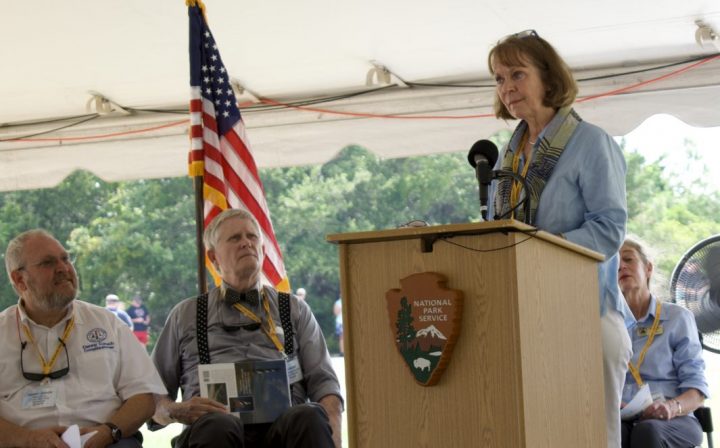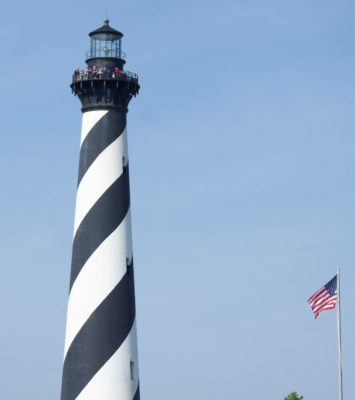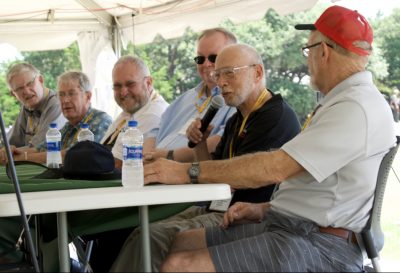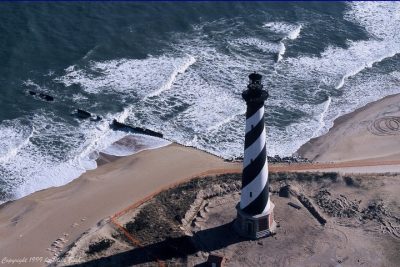
BUXTON — Back in summer 1999, Buxton was the place to be. People from all over the world poured into this tiny Outer Banks village to catch a peek as the Cape Hatteras Lighthouse inched inland for 23 days beginning June 17 in what was pegged “the Move of the Century.”
Twenty years later, the drama of that engineering feat has not dimmed – in the community or for the participants – and the significance of the project has only grown.
Supporter Spotlight

“I know my grandfather would’ve been overwhelmed by this,” Terry Ann Jennette Ponton said Monday during an anniversary celebration at Cape Hatteras Light Station. “My dad and his sisters were born in this house over here. It was very difficult for them to wrap their heads around that you could move this lighthouse. It was a very emotional time.”
Ponton’s grandfather, Unaka Jennette, was the last keeper of the lighthouse. She was joined at the event by representatives of the National Park Service, the Outer Banks Lighthouse Society and the Hatteras Island community, as well as move contractors and coastal scientists.
“By moving the lighthouse, we did not just move a brick structure,” Scott Babinowich, the National Park Service’s Outer Banks Group chief of interpretation, told the audience assembled under a tent on the lighthouse grounds. More than 250 attended. “This lighthouse has become a silent witness to the history of the Outer Banks.”
The decision to move the lighthouse was fraught, prolonged and divisive, with the Outer Banks fighting to protect the lighthouse in place, and the National Park Service wanting to relocate it a half-mile from the ocean, and with passionate allies lined up behind one side or the other.
Since it was built in 1870, the lighthouse had stood on the beach, overlooking the Atlantic with its glimmer warning ships of the infamous Diamond Shoals that are most to blame for the Outer Banks’ reputation as the “Graveyard of the Atlantic.” But in those days, the beach below was about 1,600 feet wide.
Supporter Spotlight
Even when her grandfather was keeper, Ponton said, the distance from the shoreline to the lighthouse was plenty enough for the children to play baseball. But before it was moved, the nation’s tallest brick beacon stood a mere 120 feet from the surf.
“My family knew we had a problem,” Ponton said.
The problem was that for years – decades – no one could agree what was the best way to save Cape Hatteras Lighthouse. For that matter, no one could agree on how tall the lighthouse was. When the lighthouse was moved, it was officially 208 feet tall, but now it’s described as being 198 feet tall.
Beach erosion had forced the National Park Service to temporarily abandon the lighthouse and to replace its light, a Coast Guard maritime aide, with a metal light tower. Although officials eventually restored the lighthouse to service, the erosion threat persisted, and numerous protective measures, such as sandbags, were proving ineffective.

A study done in the late 1980s by the National Academy of Sciences had recommended that the lighthouse be moved away from the ocean. But the park service lacked both funding and support to follow up on relocation and wanted to use a groin – a steel wall – to catch sand to build the beach in front of the tower. That was the temporary measure the community favored.
Then, in the mid-1990s, the park service abruptly decided to pursue relocation, and Congress provided nearly $10 million. At that, Dare County formed the Save the Lighthouse Committee. A similar committee, the Save Cape Hatteras Lighthouse Committee, founded by acclaimed North Carolina photographer Hugh Morton, also supported keeping the national landmark at its picturesque seaside location, and sympathized with its meaning to the community.
“It’s a symbol of stability and courage and the history of man’s battle with the sea,” Morton said in a March 1999 article in the Greensboro News & Record. “They think when you turn tail and run and try to move it, you diminish its value as a monument to courage.”

North Carolina’s congressional delegation and state leaders were divided, with then-U.S. Sen. Lauch Faircloth and Gov. Jim Hunt in favor and U.S. Sen. Jesse Helms and Rep. Walter Jones opposed. Then-state Sen. Marc Basnight, a Manteo native, initially supported relocation, but later backed Dare County in opposing the move.
Dare County, however, failed in its court challenge, which ended up being heard after the outbuildings were already moved and the lighthouse had been half removed from its granite foundation.
That’s when the community threw in the towel and decided to make the best of it, said Dare County Commissioner Danny Couch, a Buxton resident who at the time owned a service station in the village.
“You might recognize me as one of the fierce and outspoken critics of the move,” Couch said, noting that Hatteras Islanders had a long history of seizing opportunities, and that’s what they did. “It really was a huge economic boon.”
Couch lauded the contractors with Expert House Movers and International Chimney for being sensitive and respectful to the community, which had come to appreciate the movers’ professionalism.
And today, Couch said, the bitterness toward the park service has abated and most everyone is happy the lighthouse has been moved to a safe place.
“Life is all about redemption,” he said. “Life is all about reconciliation. You can find common ground.”

Bob Woody, who was the park service’s public information officer at the time, said that the contractors were good-natured and built rapport with everyone who intersected with the project.
“They knew what they were there for,” he recalled. “They knew what their job was. It was a congenial group of people. They were a well-oiled moving machine.”
Joe Jakubik was project manager with International Chimney, the firm in charge of the move. He said in an interview after the event that the Cape Hatteras Lighthouse project stood out in his long career, which included moving an entire terminal at Newark Liberty Airport.
Everyone working on the project knew it was different. It’s not just that at the time, it was the largest thing his company had moved – the terminal, moved the following year, was bigger but not as tall – this was an American icon. And it was a “big deal” to the park service and, most especially, the community. Everyone knew and loved the Cape Hatteras Lighthouse, Jakubik said.
“This was a defining project,” he said. “This was the project. It was the mystique of the lighthouse.”
And now, as shoreline erosion has become an increasing problem on both U.S. coasts, coastal scientists often point to Cape Hatteras Lighthouse as the finest example of the wisdom of retreat – a strategy of moving away from coastal threats rather than trying to fight them.
“What we did here was crucial,” said Stan Riggs, a coastal geologist at East Carolina University. “I guess we were naïve in thinking this would set the standard for the country.”







